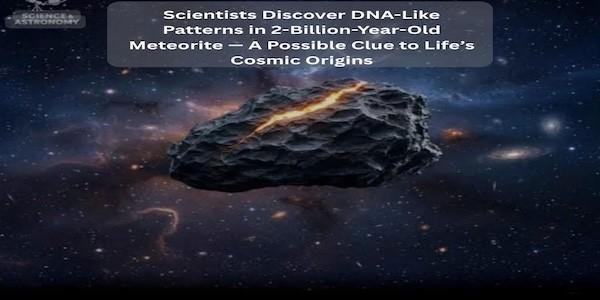Ancient Meteorite Discovery Suggests DNA-Like Codes — Could Life on Earth Have Cosmic Roots?

A new scientific revelation has reignited one of humanity’s oldest and most fascinating debates — where did life truly begin?
In a study that’s shaking up the world of astrobiology, researchers claim to have found DNA-like molecular sequences inside a meteorite believed to be nearly 2 billion years old. The implications are staggering: if these findings are confirmed, they could change everything we know about how life originated — not just on Earth, but possibly across the universe.
The Meteorite That Might Hold Life’s First Clues
The meteorite in question, according to early reports, contains complex organic molecules arranged in structured patterns eerily similar to DNA. These molecular sequences are not identical to the genetic material found in humans or other Earth life forms, but they show a familiar chemical architecture — suggesting that the fundamental recipe for life may not be unique to our planet.
To put it simply: the rock from space seems to carry a chemical “blueprint” that looks like the building blocks of biology as we know it.
This discovery raises a thrilling question — could the genetic seeds of life have arrived on Earth via ancient meteorites traveling through the void of space?
Rethinking the Origins of Life on Earth
For decades, scientists have widely accepted the abiogenesis theory — the idea that life emerged from simple chemical reactions in Earth’s early oceans. But this new evidence hints at a far grander story, one that stretches beyond our planet’s atmosphere.
If these DNA-like molecules indeed prove to be of biological origin, it could mean that life didn’t start here at all. Instead, it might have been planted here — carried across light-years on space rocks that collided with our young planet billions of years ago.
In that case, every living being on Earth — from the tiniest microbe to humanity itself — could share a cosmic ancestry, connected not just by biology, but by stardust.
The Panspermia Hypothesis Finds New Energy
The idea that life could have traveled across space isn’t new. Known as the panspermia hypothesis, it proposes that microbial life or its precursors might survive the harshness of space, shielded inside comets or meteorites, and “seed” life when they land on suitable worlds like Earth.
For years, this idea sat on the fringes of mainstream science — more philosophical than factual. But the latest findings are breathing new life into the theory. If DNA-like structures can be found in ancient meteorites, it could serve as the strongest evidence yet that panspermia is more than just science fiction.
Imagine the ripple effect: evolution itself could be seen not as an Earth-bound miracle, but as a cosmic process — one that unfolds wherever the universe allows.
Scientists Urge Skepticism and Further Testing
Of course, extraordinary claims demand extraordinary evidence. The research team behind this discovery has urged caution, emphasizing that these results are still preliminary.
While the detected structures resemble DNA in complexity, they might also be the result of non-biological chemical processes that simply mimic life-like organization. In other words, chemistry can sometimes imitate biology, especially in environments rich in carbon-based compounds.
Independent laboratories around the world are now working to replicate the findings, analyze the meteorite’s composition in greater detail, and rule out the possibility of contamination. Only through such rigorous peer review will scientists know whether we’re truly looking at ancient traces of life — or just a fascinating chemical coincidence.
A Discovery That Could Redefine Science and Philosophy
If proven authentic, this finding could become one of the most transformative moments in modern science. It would reshape our understanding of:
- Astrobiology: Expanding the search for life beyond Earth’s biosignatures.
- Evolutionary biology: Reframing how life’s genetic codes evolved and spread.
- Planetary science: Highlighting meteorites as possible carriers of life.
- Philosophy and spirituality: Forcing humanity to confront profound questions about our origins and our place in the cosmos.
Are we truly products of Earth — or descendants of an ancient, cosmic lineage? Could our DNA be an echo of a much older genetic code, written somewhere among the stars?
What Comes Next: The Search Continues
For now, the world watches with curiosity and awe. As more data comes in, scientists hope to better understand the meteorite’s origins, age, and the precise nature of its molecular structures.
Future missions to Mars, Europa, and other celestial bodies will also look for similar DNA-like compounds. If matching structures are found elsewhere, it would strengthen the argument that life — or at least its raw ingredients — is widespread throughout the universe.
This discovery is a reminder that every rock from space could hold secrets billions of years old — messages written in molecules, waiting for us to decipher.
A Cosmic Perspective
Whether or not this particular meteorite truly carried the seeds of life, it has already achieved something remarkable — it’s rekindled our sense of wonder. It reminds us that science is not just about answers, but about asking ever deeper questions.
Perhaps we are not just from Earth, but of the universe itself — formed from star dust, carried by cosmic winds, and shaped by time.
The story of life, it seems, may not have begun in the oceans of our planet, but in the vast, shimmering sea of space.



